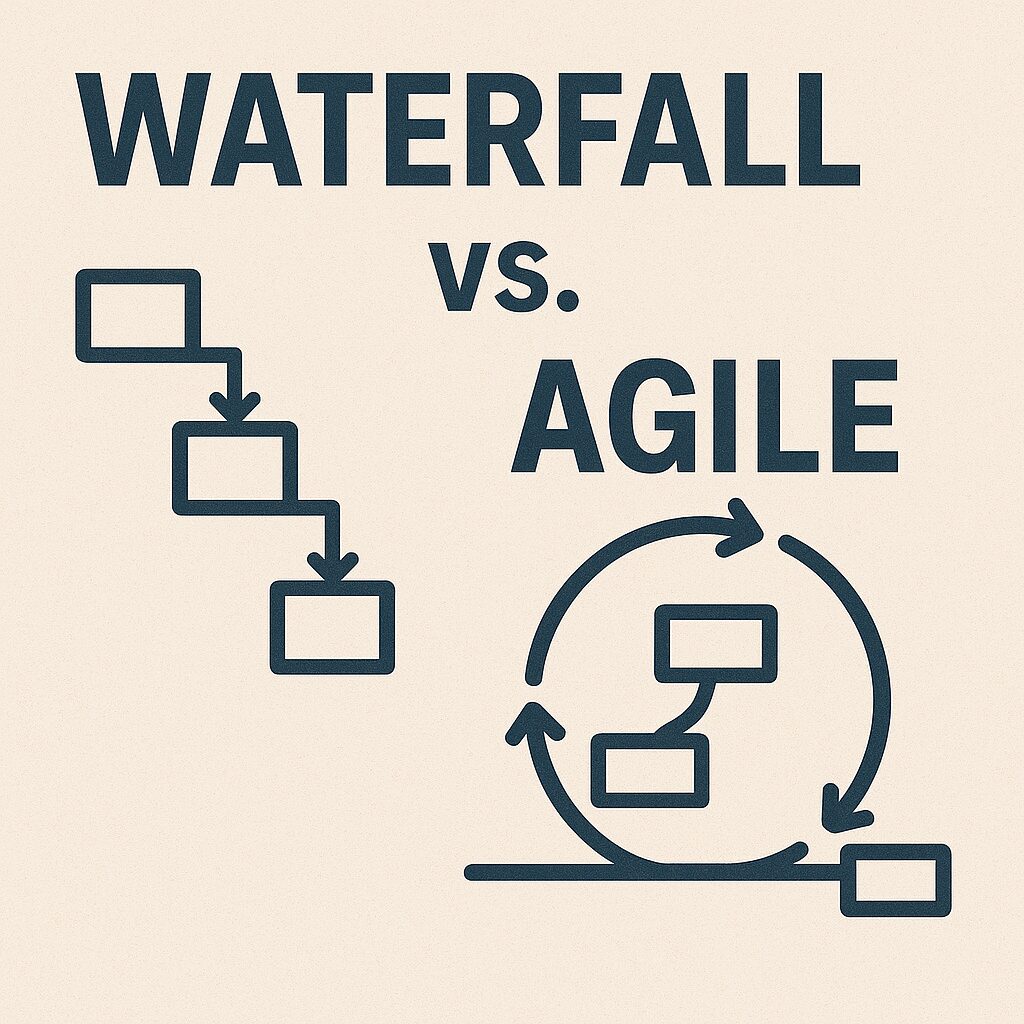Waterfall vs. Agile: How to Choose the Right Project Management Method
You’ve created your strategic plan. You’ve taken that big, ambitious goal and broken it down into a focused 90-Day Action Plan. Your “Quarterly Rock” is defined.
Now comes the hard part: execution.
Have you ever managed a project that felt like pure chaos? Deadlines slip, team members are confused about their priorities, and the final result looks nothing like what you originally envisioned. This kind of chaos isn’t a sign of a bad team; it’s usually a sign of a bad system.
The most common mistake founders make is using the wrong tool for the job. They have one project management “hammer” and they try to use it for every single project.
Today, we’re going to give you a complete toolkit. We’ll demystify the two core philosophies of project management—Waterfall and Agile—and give you a simple framework to choose the right one, every time.
The Two Core Philosophies of Getting Things Done
While there are dozens of specific methodologies, they all stem from two primary ways of thinking.
1. Waterfall: The Architect’s Blueprint
The Waterfall method is the traditional, linear approach to project management. Think of it like building a house: you have distinct, sequential phases, and you don’t move to the next one until the previous one is 100% complete.
Phases: Requirements -> Design -> Build -> Test -> Launch
You would never start building the walls before the architectural blueprint is finalized and approved. Waterfall is perfect for projects where the end goal is crystal clear and unlikely to change. It relies heavily on upfront planning and detailed documentation. A tool like PandaDoc is excellent for this, allowing you to create and get sign-off on detailed project scope documents before any work begins.
- Best for: Predictable projects with a fixed scope, like opening a new retail location or running a compliance audit.
2. Agile: The Explorer’s Compass
The Agile method was born in the software world to deal with uncertainty and change. Think of it like exploring a new continent: you have a general direction you want to go, but you expect to adapt your path based on the terrain you discover.
Instead of one long project, Agile breaks work into short cycles called “sprints” (usually 1-4 weeks). At the end of each sprint, the team delivers a small, working piece of the project, gets feedback, and adjusts the plan for the next sprint.
- Best for: Innovative or complex projects where the end goal might evolve, like developing a new software feature, creating a new marketing campaign with AdCreative.ai, or building a new online course with LearnWorlds.
How to Choose: The Clarity Matrix
So, how do you pick the right method for your “Quarterly Rock”? You can diagnose your project by asking two simple questions.
(Imagine a 2×2 grid)
- The “WHAT” (Y-Axis): On a scale of 1-10, how clear is the final outcome?
- The “HOW” (X-Axis): On a scale of 1-10, how clear is the path to get there?
- High Clarity WHAT + High Clarity HOW: The goal is clear, and the steps are known. This is a perfect candidate for Waterfall. Your goal is efficient execution, not discovery.
- Low Clarity WHAT + Low Clarity HOW: The goal is fuzzy, and the path is unknown. You must use Agile. Your goal is to learn as quickly as possible and adapt.
A flexible Work OS like monday.com is powerful because it can be configured to manage either style of project, from a rigid, phase-gated Waterfall plan to a dynamic Agile sprint board.
The Strategic Trade-Off: What Risk Are You Managing?
Your choice of method is ultimately a strategic decision about risk.
- Waterfall minimizes execution risk. With a perfect plan, you’re less likely to go over budget or miss deadlines. However, it maximizes market risk—the danger that you spend six months perfectly building something nobody actually wants.
- Agile minimizes market risk. By getting constant feedback, you’re unlikely to build the wrong thing. However, it can increase execution risk—the scope can change, making timelines and final budgets less predictable. Tracking your project expenses carefully in QuickBooks is critical in an Agile environment.
Your Action Plan: The Project Placement Test
Your mission this week is to bring clarity to your most important project.
- Take your #1 “Quarterly Rock.”
- Draw the Clarity Matrix on a piece of paper.
- Place your project in one of the four quadrants.
- Ask the critical question: “Is the method we’re currently using the right one for this quadrant?”
This simple diagnosis can save you months of frustration. It ensures that your process serves your project, turning your brilliant strategy into a successful reality.
Need Help Tracking Your Strategic Goals?
Choosing the right project method is a key part of executing your strategy. But it all starts with knowing what your goals are. The Profit & Pivot Toolkit below includes my CEO Dashboard template, designed to help you track your most important metrics and ensure your projects are driving real business results.
[download_after_email id=”671″]

